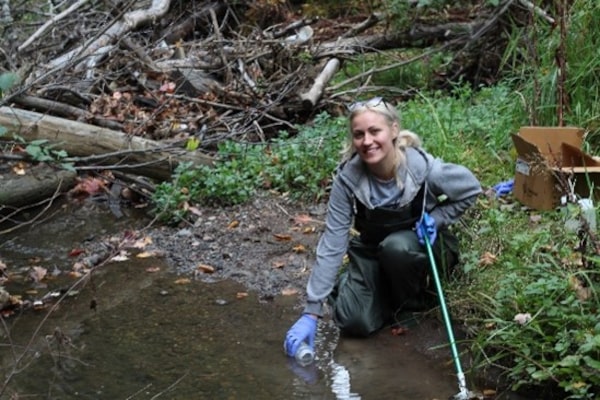
Dr. Daniel Heath, fish conservation genomics expert and professor at the University of Windsor, OntarioHandout
Let’s Talk Science and the Royal Society of Canada have partnered to provide Globe and Mail readers with relevant coverage about issues that affect us all – from education to the impact of leading-edge scientific discoveries. This article first appeared in English in this Globe and Mail hub.
Dr. Catalina Lopez-Correa is Chief Scientific Officer at Genome Canada
Who’s been here before us? Scientists are increasingly using environmental DNA (eDNA) to answer that question.
Animals – including us – are constantly shedding bits of themselves in the form of dead skin cells, mucus or feces, all of which contain DNA. This eDNA can be extracted from the air, soil, water and even from surfaces in your home.
Filter water from a lake for example, analyse the leftover sludge, and you can learn what fish species live there by comparing the DNA to a database of existing species. You can also get a rough idea of numbers, including whether their populations are rising or falling. You can even learn how healthy the fish are, and if they are stressed, by examining whether their immune system or stress-related genes are active.
Compared to traditional forms of wildlife monitoring, it’s a non-intrusive, less labour-intensive and cheaper way of learning what’s happening underwater. eDNA analysis doesn’t require you to capture animals or even to see them.
That’s a good thing when it comes to keeping an eye on the populations and health of species that can be hard to find and identify by sight – some species of freshwater mussels for example don’t look much different from others. But eDNA can reveal their genetic diversity.
A deep dive into Canada’s freshwater fisheries
Getting a handle on genetic diversity is crucial for protecting the world’s freshwater fisheries, which are under growing pressure from climate change, farm fertilizer runoff, hydropower dams and pollution. While most headlines focus on declines in iconic ocean fish such as Atlantic cod and bluefin tuna, freshwater species face far worse: freshwater vertebrate populations have decreased 85 per cent since the 1970s.
That’s why Daniel Heath, an expert in fish conservation genomics at the University of Windsor, is leading a group of researchers on a four-year eDNA study of more than 1,000 lakes and rivers across Canada. “Thriving freshwater fish resources are the lifeblood of many rural, northern and Indigenous communities,” he says. “They are central to the social and cultural lives of millions of Canadians.”
With more than two million lakes and countless rivers in this country, Heath and his team believe eDNA could help us more effectively monitor and manage our vast freshwater ecosystems and fisheries. With support from Ontario Genomics, Genome Prairie and Genome Canada, he is partnering with a dozen Canadian universities and five Indigenous communities to use genomic approaches to develop a fish survey toolkit based on eDNA from water samples.
The team will also create a fish health toolkit to assess the health of fish and the stressors they face, such as warming waters, pollution, predators and invasive species. The goal is to use the toolkits to help manage both wild-caught and farmed fish.
“For the first time, it will be possible to answer critical questions, such as: Where are the important freshwater fishes? How many are there? How are they coping with environmental stressors?” says Heath.
Power to the people
Heath says he is especially excited to be working with Indigenous communities, which include the Chippewas of Nawash Unceded First Nation, near Cape Croker, Ontario; the Chippewas of Saugeen First Nation, near Southampton, Ontario; the Secwepemc Fisheries Commission in BC’s southern interior; the Tsay Keh Dene Nation in northern BC and the Athabasca Chipewyan First Nation / Mikisew Cree First Nation, near Wood Buffalo National Park in northern Alberta.
He hopes his toolkits can give these groups more control over their own fisheries. “Any community can collect water, filter it and send it to a lab for analysis,” he says. “They don’t have to wait for a government biologist to analyse and respond to any concerns they may have.”
Significantly, Heath’s project includes an economic and social analysis to make sure the toolkits are responsive to a given community’s needs. As Genome Canada’s Chief Scientific Officer, I can tell you supporting this kind of research can not only help fisheries and wildlife managers everywhere do their jobs more efficiently, it can put more power in the hands of Indigenous peoples and other groups.
For example, Génome Québec’s ADN-Eau citizen science program for school-age youth involves high school students across Quebec collecting genomic data to better understand the state of biodiversity in waterways through eDNA. While it’s a good learning project for students, it’s not just an educational opportunity.
Another example is a biodiversity protection project that tracks the impact of global climate changes on the environment. Led out of Genome BC and Génome Québec, this work is developing standardized methods and accessible eDNA resources to support ecological surveys, increase environmental quality standards and position Canada as an international leader in this space.
The data will be kept in a database and made available to the scientific community and government departments. In other words, you don’t have to be a scientist—or even an adult—to use eDNA to make a difference in the water in your community.

Shelby Wright, MSc student, University of Windsor, sampling water for eDNAHandout